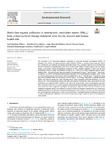Multi-Class Organic Pollutants in Atmospheric Particulate Matter (PM2.5) From a Southwestern Europe Industrial Area: Levels, Sources and Human Health Risk

Use este enlace para citar
http://hdl.handle.net/2183/32408
A non ser que se indique outra cousa, a licenza do ítem descríbese como Atribución 4.0 Internacional
Coleccións
- Investigación (FCIE) [1231]
Metadatos
Mostrar o rexistro completo do ítemTítulo
Multi-Class Organic Pollutants in Atmospheric Particulate Matter (PM2.5) From a Southwestern Europe Industrial Area: Levels, Sources and Human Health RiskAutor(es)
Data
2022-08Cita bibliográfica
Joel Sánchez-Piñero, Natalia Novo-Quiza, Jorge Moreda-Piñeiro, Isabel Turnes-Carou, Soledad Muniategui-Lorenzo, Purificación López-Mahía, Multi-class organic pollutants in atmospheric particulate matter (PM2.5) from a Southwestern Europe industrial area: Levels, sources and human health risk, Environmental Research, Volume 214, Part 4, 2022, 114195, ISSN 0013-9351, https://doi.org/10.1016/j.envres.2022.114195. (https://www.sciencedirect.com/science/article/pii/S0013935122015225)
Resumo
[Abstract] The occurrence of 50 multi-class pollutants comprising 18 polycyclic aromatic hydrocarbons (PAHs), 12 phthalate esters (PAEs), 12 organophosphorus flame retardants (OPFRs), 6 synthetic musk compounds (SMCs) and 2 bisphenols was studied in atmospheric particulate matter (PM2.5) samples collected at an industrial area focused on automotive manufacturing located at the Southwestern Atlantic European region (Vigo city, Spain) during 1-year period. Among all quantitated pollutants in PM2.5 samples, bisphenol A (BPA) was the most predominant with an average concentration of 6180 pg m−3, followed by PAHs comprising benzo(b+j)fluoranthene (BbF + BjF) and benzo(g,h,i)perylene (BghiP), accounting for 546 pg m−3 and 413 pg m−3 respectively. In addition, two OPFRs concerning tris(chloropropyl) phosphate (TCPP) and triphenyl phosphine oxide (TPPO) were the next following the concentration order, accounting for 411 pg m−3 and 367 pg m−3 respectively; being butyl benzyl phthalate (BBP) the most profuse PAE (56.1 pg m−3 by average). High relative standard deviations (RSDs) were observed during the whole sampling period, while statistically significant differences were only observed for PAHs concentrations during cold and warm seasons. Furthermore, some water-soluble ions and metal(oid)s were analysed in PM2.5 samples to be used as PM source tracers, whose concentrations were quite below the target levels set in the current legislation. Data obtained from principal component analysis (PCA) and PAHs molecular indices suggested a pyrogenic and petrogenic origin for PAHs, whereas occurrence of the remaining compounds seems to be attributed to resources used in the automotive industrial activity settled in the sampling area. Moreover, although a substantial anthropogenic source to PM2.5 in the area was observed, marine and soil resuspension contributions were also accounted. Finally, carcinogenic and non-carcinogenic risks posed by PM2.5-bound pollutants inhalation were assessed, being both averages within the safe level considering the whole period.
Palabras chave
Organic pollutants
Industrial chemicals
Fine particulate matter
Seasonal trends
PM source Apportionment
Health risk assessment
Industrial chemicals
Fine particulate matter
Seasonal trends
PM source Apportionment
Health risk assessment
Descrición
Financiado para publicación en acceso aberto: Universidade da Coruña/CISUG
Versión do editor
Dereitos
Atribución 4.0 Internacional
ISSN
0013-9351






